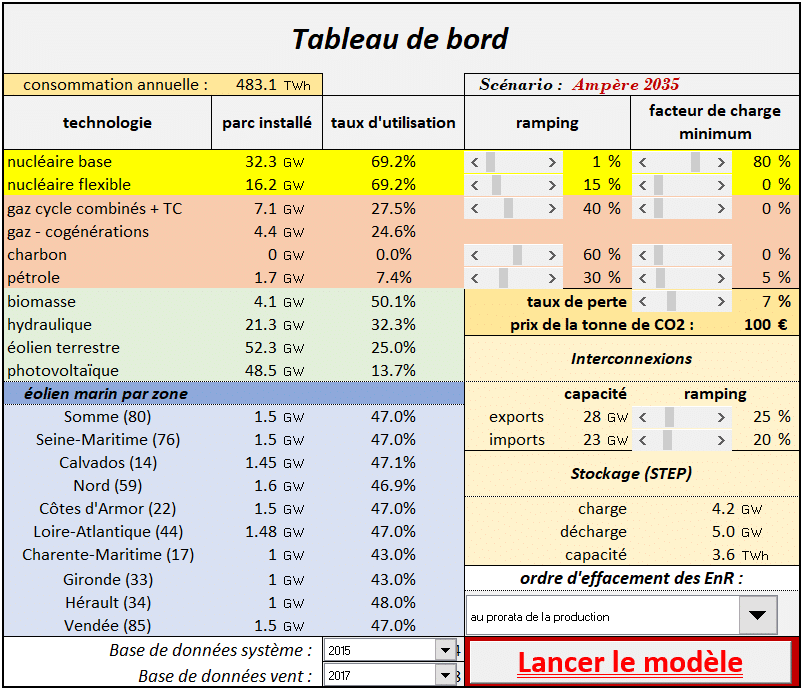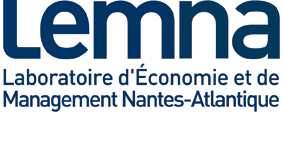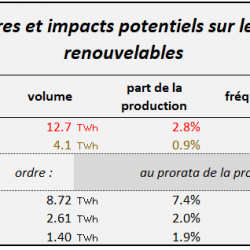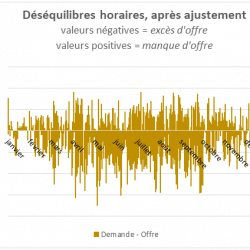
Background
The EMA project builds energy mix scenarios applied to the French power system, in line with commitments of the national Energy Transition Act (LTECV, 2015; PPE, 2019). The goal is to simulate the mass deployment of the off-shore wind energy in 2035/2050, in order to assess the market effects from a system perspective with concern to balance and flexibility needs. A model is built to optimize the dispatching of all generator types (with programmable output and with intermittent input) and describes the operation of the power market at hour time-step over one year, based on the merit order of marginal costs. The EMA project tests also a set of order principles for plant curtailment on the market. In power systems with large inflows of variable wind and solar power, all technologies are called to follow the load, and locally to reduce their output. As variable input power plants will most likely be called to shut-down some generators, a prior analysis becomes necessary to anticipate the criteria to be considered, such as the Capex, the site location, the capacity factor, and the share into the total generation. To best estimate the mix complementarity contribution, the three main patterns of off-shore wind in France are integrated into the model database, resulting in an indicator of the firm capacity of the off-shore wind farms in project.
Scientific advances and innovation
The project simulates the mass deployment of off-shore wind energy. Variable input power plants will most likely be called to punctually shut-down. The EMA project anticipates how technical and regulatory drivers will set the priority on the market of technologies in case of excess of supply.
Expected technical and economic impact
Technology part: fixed off-shore wind. The dispatching model simulates the integration into the grid of technologies included into the Energy Transition Act, and depicts in particular the deployment of off-shore wind energy. Hourly inputs are documented such as to realistically account for the site location along the French coasts and for wind turbine characteristics for projects in 2035 (see the website renewables.ninja).
Economic part. The EMA project builds on microeconmics of power market and supply and demand balance principle applied at any hour, under the constraint of technology interaction. Market constraints from the demand side such as the amplitude of volumes and grid interconnections for export and import, face the technology constraints to adjust the power up and down in load-following way, to ultimately estimate the volume to be sold on the market, i.e. the economic potential out of the technological potential.
Key project milestones
- May 2020 - Launching
- July 2020 - End of model building. Sensitivity tests
- August 2020 - End of project-Communcation
Demonstrator
The tool is developed in Excel / VBA (Visual Basic for Applications) and integrates a rich data base of inputs. An algorithm is developed to simulate a decentralized power market, with hourly outputs such as the power generated with each of the eleven representative technologies and two energy storage types. The model inputs are the installed capacities of power plants, the hourly capacity factors of variable renewables (hydro, off and on-shore wind power and solar), operation constraints (ramping and minimum thresholds), grid interconnections, hourly demand profile, loss rate, the carbon price and the reference year. The outputs are the power volume generated every hour over the year (8760 steps), export and import flows, carbon emissions, and the power curtailment from the demand and supply sides. The power market operation is based on the call of technologies under the constraint of supply and demand equilibrium, considering the availability of power plants and of natural inflows.
The demonstrator is intended for energy operators, researchers, students and energy stakeholders aiming to build and test scenarios of the French mix. Due to user-friendly interface, the model integrates already built scenarios (RTE 2035 Ampère and Watt, Ademe 2050), or can test alternative scenarios built by the user, with different installed capacities of generation and storage, export-import and total demand. The simulator includes an explanatory notice to make the user familiar with files and commands; while a more detailed manual presents model’s assumptions, the algorithm, and result analysis.
Results
Results of simulations show that when renewables’ share attains 50% in the total generation, the power system faces eventual disequilibria due to power in excess or to shortages over the year. Moreover, the integration of renewables heavily relies on the development of grid interconnections and on export and import flows to balance the system. This translates into large needs of flexibility from the system and further suggests installing and using more energy storage systems, like pumped hydro storage and batteries.
Prospects
In a first step, the tool will be tested by energy operators and actors involved into the energy transition such as to improve the understanding and the use of the model. Then, the project results will be published in scientific journals. Overall, the collaboration between the two research centers LEMNA – LHEEA on the topic of wind energy integration into the grid could open perspectives on future work on energy storage, like hydrogen and batteries. The geographical area could be extended, to other partners at international level through European projects applied to Atlantic coast and North Sea projects.







